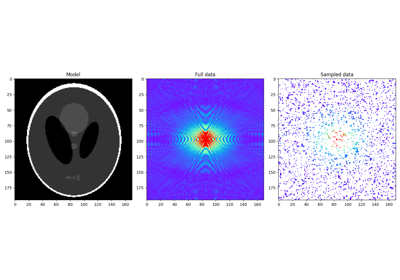pyproximal.optimization.pnp.PlugAndPlay#
- pyproximal.optimization.pnp.PlugAndPlay(proxf, denoiser, dims, x0, solver=<function ADMM>, **kwargs_solver)[source]#
Plug-and-Play Priors with any proximal algorithm of choice
Solves the following minimization problem using any proximal a lgorithm of choice:
\[\mathbf{x},\mathbf{z} = \argmin_{\mathbf{x}} f(\mathbf{x}) + \lambda g(\mathbf{x})\]where \(f(\mathbf{x})\) is a function that has a known gradient or proximal operator and \(g(\mathbf{x})\) is a function acting as implicit prior. Implicit means that no explicit function should be defined: instead, a denoising algorithm of choice is used. See Notes for details.
- Parameters
- proxf
pyproximal.ProxOperator Proximal operator of f function
- denoiser
func Denoiser (must be a function with two inputs, the first is the signal to be denoised, the second is the tau constant of the y-update in PlugAndPlay)
- dims
tuple Dimensions used to reshape the vector
xin theproxmethod prior to calling thedenoiser- x0
numpy.ndarray Initial vector
- solver
pyproximal.optimization.primalorpyproximal.optimization.primaldual Solver of choice
- kwargs_solver
dict Additonal parameters required by the selected solver
- proxf
- Returns
- out
numpy.ndarrayortuple Output of the solver of choice
- out
Notes
Plug-and-Play Priors [1] can be used with any proximal algorithm of choice. For example, when ADMM is selected, the resulting scheme can be expressed by the following recursion:
\[\begin{split}\mathbf{x}^{k+1} = \prox_{\tau f}(\mathbf{z}^{k} - \mathbf{u}^{k})\\ \mathbf{z}^{k+1} = \operatorname{Denoise}(\mathbf{x}^{k+1} + \mathbf{u}^{k}, \tau \lambda)\\ \mathbf{u}^{k+1} = \mathbf{u}^{k} + \mathbf{x}^{k+1} - \mathbf{z}^{k+1}\end{split}\]where \(\operatorname{Denoise}\) is a denoising algorithm of choice. This rather peculiar step originates from the intuition that the optimization process associated with the z-update can be interpreted as a denoising inverse problem, or more specifically a MAP denoiser where the noise is gaussian with zero mean and variance equal to \(\tau \lambda\). For this reason any denoising of choice can be used instead of a function with known proximal operator.
Finally, whilst the \(\tau \lambda\) denoising parameter should be chosen to represent an estimate of the noise variance (of the denoiser, not the data of the problem we wish to solve!), special care must be taken when setting up the denoiser and calling this optimizer. More specifically, \(\lambda\) should not be passed to the optimizer, rather set directly in the denoiser. On the other hand \(\tau\) must be passed to the optimizer as it is also affecting the x-update; when defining the denoiser, ensure that \(\tau\) is multiplied to \(\lambda\) as shown in the tutorial.
Alternative, as suggested in [2], the \(\tau\) could be set to 1. The parameter \(\lambda\) can then be set to maximize the value of the denoiser and a second tuning parameter can be added directly to \(f\).

